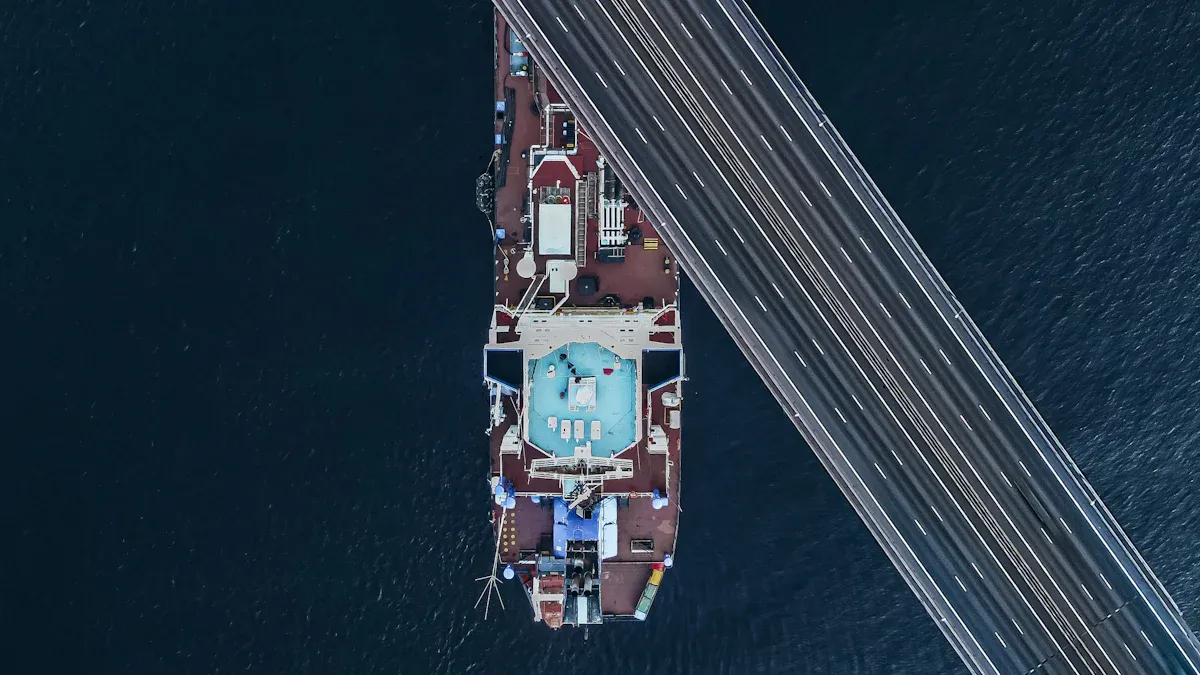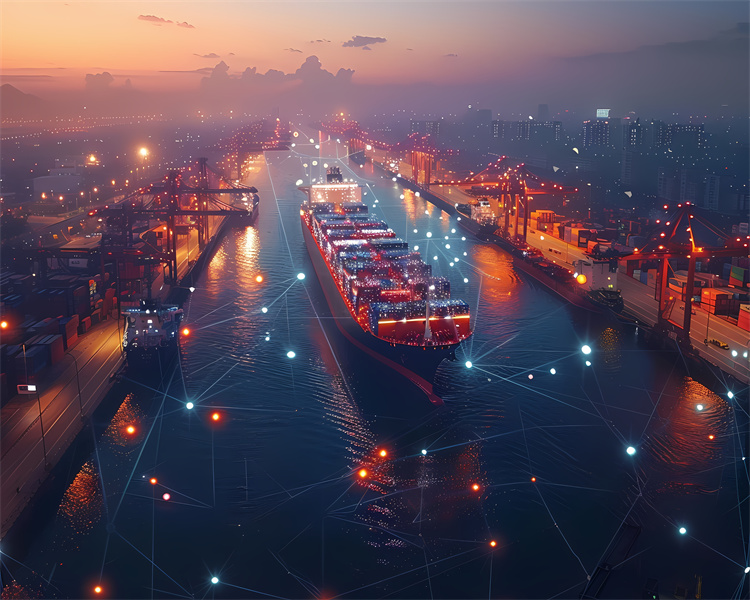5 Ways China’s Belt and Road Initiative is Reshaping Global Supply Chain

The Belt and Road Initiative (BRI) has emerged as a transformative force in global supply chains. By prioritizing infrastructure development and fostering economic partnerships, it has significantly reduced trade costs and transit times. For instance, shipment times have decreased by up to 3.2%, while trade costs have dropped by nearly 2.8%. These advancements have spurred economic growth, with Asia alone witnessing a potential welfare increase of $94 billion. China's strategic investments in seaborne trade are also projected to boost Suez Canal cargo volumes by 23%, further solidifying its role in global logistics. This innovation continues to reshape international trade dynamics.
Transforming Global Trade Infrastructure

Building New Transport Corridors
Railways Connecting China to Europe
China's Belt and Road Initiative (BRI) has revolutionized global trade by establishing new rail corridors that connect China to Europe. These railways provide a faster and more cost-effective alternative to traditional sea routes. For instance, the China-Europe Express Rail reduces shipment times to just 15-20 days, offering a middle ground between the speed of air freight and the affordability of sea freight. This development has significantly enhanced trade efficiency, with shipment times decreasing by 1.7–3.2% and trade costs dropping by 1.5–2.8%. These railways have become a lifeline for industries like electronics, clothing, and medical supplies, ensuring timely delivery across continents.
Maritime Routes Enhancing Port Connectivity
Maritime routes under the BRI have strengthened port connectivity, creating a seamless flow of goods between Asia, Africa, and Europe. Investments in vital infrastructure, such as ports in Southeast Asia and Africa, have streamlined global trade. Enhanced port facilities have reduced bottlenecks, enabling faster cargo handling and boosting trade flows by 2.7% to 9.7% in participating countries. These maritime routes not only support large-scale trade but also integrate underdeveloped regions into the global economy, fostering economic growth and cooperation.
Upgrading Existing Infrastructure
Modernizing Ports in Africa and Southeast Asia
The BRI has prioritized modernizing ports in Africa and Southeast Asia, transforming them into global trade hubs. Upgraded ports in these regions now handle larger volumes of cargo with improved efficiency. This modernization has reduced shipment times by up to 3.2%, making trade more accessible and cost-effective. By focusing on less developed areas, the initiative has unlocked new economic opportunities, integrating these regions into the global supply chain.
Enhancing Road Networks in Central Asia
China's investments in road networks across Central Asia have bridged critical gaps in trade routes. These enhanced roads connect remote inland cities to major trade corridors, reducing transit times and fostering regional trade. Improved road infrastructure has also lowered trade costs by 1.5–2.8%, enabling businesses to expand their market reach. This focus on infrastructure development has positioned Central Asia as a key player in global trade under the BRI framework.
Reducing Trade Costs and Transit Times
Streamlining Customs and Border Processes
Digital Trade Platforms and E-Commerce Integration
China's Belt and Road Initiative (BRI) has introduced digital trade platforms that simplify customs and border processes. These platforms leverage advanced technologies like blockchain and artificial intelligence to enhance transparency and efficiency. By digitizing documentation and automating customs clearance, businesses experience fewer delays and reduced administrative burdens. E-commerce integration further streamlines cross-border transactions, enabling companies to expand their global reach. This digital transformation has contributed to shipment time reductions of 1.7–3.2% and trade cost decreases of 1.5–2.8%, making international trade more accessible and cost-effective.
Bilateral Agreements to Simplify Trade
Bilateral agreements under the BRI have played a pivotal role in reducing trade barriers. These agreements harmonize customs regulations and establish standardized procedures across participating countries. As a result, businesses benefit from faster processing times and lower compliance costs. For instance, agreements between China and Central Asian nations have facilitated smoother trade flows, fostering economic growth in the region. By prioritizing collaboration, the BRI has created a more interconnected and efficient global trade network.
Faster Shipping Routes
The Role of China-Europe Express Rail in Cost and Time Efficiency
The China-Europe Express Rail exemplifies the BRI's commitment to faster shipping routes. This rail service offers a balanced solution between speed and cost, with transit times of 15–20 days. It provides a faster alternative to sea freight and a more affordable option compared to air freight. By reducing transit times, the rail service has significantly lowered logistics costs for businesses. Industries like electronics, clothing, and medical supplies rely on this service to ensure timely deliveries, enhancing their supply chain efficiency.
Impact on Perishable Goods and Time-Sensitive Industries
Faster shipping routes have revolutionized the transportation of perishable goods and time-sensitive products. The China-Europe Express Rail, for example, ensures that fresh produce, pharmaceuticals, and other critical items reach their destinations promptly. Reduced transit times minimize spoilage and maintain product quality, benefiting industries that depend on rapid delivery. Additionally, China's investments in the Suez Canal have increased trade efficiency, with a projected 23% rise in cargo volumes. This improvement underscores the importance of faster routes in reducing logistics costs and supporting global trade.
Strengthening Regional Economic Integration
Promoting Cross-Border Trade
Economic Corridors like the China-Pakistan Economic Corridor (CPEC)
The China-Pakistan Economic Corridor (CPEC) exemplifies the transformative impact of belt and road cooperation on cross-border trade. This strategic initiative connects China's western regions to Pakistan's Gwadar Port, creating a vital trade and investment program. By reducing transit times and enhancing connectivity, CPEC has fostered high-quality development in both nations. The corridor has also stimulated market growth by integrating regional supply chains and enabling seamless trade flows. Research highlights that such corridors lower trade costs and improve trade efficiency, driving economic growth across participating regions.
Key achievements of CPEC include:
Enhanced infrastructure, such as highways and energy projects.
Increased bilateral trade volumes between China and Pakistan.
Creation of new economic zones to attract foreign investment.
Trade Hubs in Southeast Asia
Southeast Asia has emerged as a focal point for high-quality development under the Belt and Road Initiative. Investments in infrastructure have transformed cities like Kuala Lumpur and Bangkok into thriving trade hubs. These hubs serve as gateways for goods moving between China and global markets, boosting regional growth. The total trade volume between China and belt and road cooperation countries rose from $1.63 trillion in 2013 to $2.9 trillion in 2022, showcasing the initiative's success in fostering market integration. By prioritizing innovation and strategic partnerships, these hubs have unlocked new opportunities for businesses and strengthened regional trade networks.
Encouraging Regional Cooperation
Multilateral Trade Agreements Under the Belt and Road Initiative
Multilateral trade agreements play a pivotal role in advancing belt and road cooperation. These agreements harmonize customs regulations and streamline trade processes, enabling high-quality development across participating nations. For example, the Belt and Road Initiative's framework of six corridors and routes enhances trade and investment opportunities. This strategic approach has facilitated market growth by integrating industry chains and expanding regional markets. Additionally, China's direct investment in belt and road cooperation countries has surpassed $240 billion, further solidifying its role as a global economic leader.
Shared Infrastructure Projects Fostering Collaboration
Shared infrastructure projects under the Belt and Road Initiative have delivered measurable economic benefits. These projects include clean water initiatives in Cameroon and Ethiopia, health care programs, and industrial cooperation efforts. By fostering collaboration, these initiatives have improved living standards and supported sustainable growth. The table below highlights key examples:
Project Type | Description |
|---|---|
Infrastructure Connectivity | Development of six corridors to enhance trade and investment. |
Health Care Initiatives | Over 300 projects launched in participating countries. |
Clean Water Projects | Initiatives in Cameroon, Ethiopia, and Djibouti for clean drinking water. |
Industrial Cooperation | Integration of industry chains to expand regional markets. |
These shared projects underscore the importance of strategic partnerships in achieving high-quality development and fostering market-driven growth.
Diversifying Supply Chain Networks

Reducing Reliance on Traditional Trade Routes
Alternatives to the Suez Canal and Other Chokepoints
China's Belt and Road Initiative (BRI) has introduced alternative trade routes to reduce dependency on traditional chokepoints like the Suez Canal. These new pathways aim to alleviate congestion and mitigate risks associated with geopolitical tensions or natural disruptions. By diversifying supply chains, businesses gain more reliable options for transporting goods. For instance, the China-Europe Express Rail offers a faster and cost-effective alternative to maritime routes, ensuring uninterrupted trade flows. This strategic shift enhances the resilience of global supply chains, enabling industries to adapt to changing market dynamics.
New Trade Routes Through Central Asia and the Arctic
The BRI has prioritized the development of trade routes through Central Asia and the Arctic, creating a comprehensive network of railways and highways. These routes enhance connectivity and diversify supply chains, breaking existing bottlenecks in Asian trade. Central Asia's improved infrastructure facilitates seamless transportation of goods, while Arctic routes provide shorter shipping distances between Asia and Europe. This diversification strengthens global supply chains by offering alternative pathways that reduce transit times and costs, fostering economic growth across regions.
Supporting Emerging Markets
Investments in Africa’s Manufacturing and Logistics Sectors
China's investments in Africa under the BRI have significantly boosted the continent's manufacturing and logistics sectors. Infrastructure projects, such as modernized ports and enhanced road networks, have improved regional connectivity and trade efficiency. These developments enable African nations to integrate into global supply chains, unlocking new economic opportunities. Research highlights that BRI investments have increased trade volumes and attracted foreign direct investment, driving growth in emerging markets. This progress underscores the transformative impact of China's strategic initiatives on underdeveloped regions.
Boosting Trade in Underdeveloped Regions
The BRI has played a pivotal role in boosting trade in underdeveloped regions by enhancing transportation infrastructure and fostering international collaboration. Total trade volume between China and BRI countries rose from $1.63 trillion in 2013 to $2.9 trillion in 2022, reflecting the initiative's success in strengthening supply chains. Direct investments exceeding $240 billion have further accelerated the growth of manufacturing and logistics sectors. These advancements empower underdeveloped regions to participate in global trade, creating a more inclusive and interconnected economy.
Shaping Geopolitical and Economic Influence
Strengthening China’s Role in Global Trade
Expanding China’s Export Markets
The Belt and Road Initiative (BRI) has significantly expanded China's export markets, reinforcing its position as a global trade leader. By fostering trade partnerships with over 152 countries and 32 international organizations, China has created a vast network of economic cooperation. Between 2013 and 2022, trade volume between China and BRI countries surged from $1.63 trillion to $2.9 trillion, with a cumulative total exceeding $19.1 trillion. This growth highlights the initiative's success in integrating emerging markets into global trade. Additionally, China's direct investment in BRI countries surpassed $240 billion during this period, further solidifying its influence in developing economies.
The BRI also promotes the Renminbi as an international currency, reducing trade frictions like tariffs and transport costs. This strategic approach enhances China's economic and political influence, particularly in regions with underdeveloped infrastructure. By prioritizing connectivity and innovation, the initiative has reshaped trade patterns, enabling China to establish itself as a dominant force in global commerce.
Increasing Influence in Developing Economies
China's investments under the BRI have transformed developing economies by improving infrastructure and fostering economic growth. For instance, Chinese seaborne trade accounted for 30% of global Suez Canal cargo in 2022, reflecting its growing role in international trade. Enhanced port operations and bilateral agreements have strengthened China's ties with developing nations, creating mutually beneficial trade relationships. These efforts not only boost China's export markets but also position it as a key partner in global economic development.
Challenging Existing Trade Powers
Competition with Western-Led Trade Initiatives
The BRI represents a shift in global trade dynamics, challenging traditional Western-led trade models. By emphasizing trade complementarity over competition, China has created a new economic framework that prioritizes connectivity and shared growth. This approach contrasts with Western models, which often focus on competition and market dominance. The BRI's emphasis on maritime and land-based networks has restructured global trade routes, connecting previously isolated regions and enhancing economic integration.
Shifting Global Trade Dynamics in Favor of the Global South
China's strategic ties with the Global South have reshaped global trade dynamics. Investments in infrastructure and economic corridors have empowered developing nations, enabling them to participate more actively in international trade. The BRI's focus on shared development has fostered collaboration among participating countries, reducing reliance on traditional Western trade powers. This shift underscores China's role as a catalyst for inclusive economic growth, promoting a more balanced global trade system.
The Belt and Road Initiative (BRI) has redefined global supply chains by fostering infrastructure development, reducing trade costs, and promoting regional integration. Since its inception in 2013, the initiative has significantly increased trade volume between china and participating countries, rising from $1.63 trillion to $2.9 trillion by 2022. Direct investments exceeding $240 billion have further solidified its long-term impact on global trade structures.
JUSDA, with its innovative solutions like the China-Europe Express Rail, empowers businesses to navigate these changes effectively. By offering faster transit times and cost-efficient logistics, JUSDA ensures seamless connectivity between china and Europe. Its advanced supply chain platforms enhance transparency and collaboration, enabling industries to adapt to evolving trade dynamics.
As global trends shift towards multipolarity and economic globalization, the BRI's role in linking china with Europe, Africa, and beyond will continue to grow. Businesses must embrace these opportunities to remain competitive in an interconnected world.
The BRI exemplifies china's commitment to shared economic growth, creating a resilient and inclusive global trade network.
